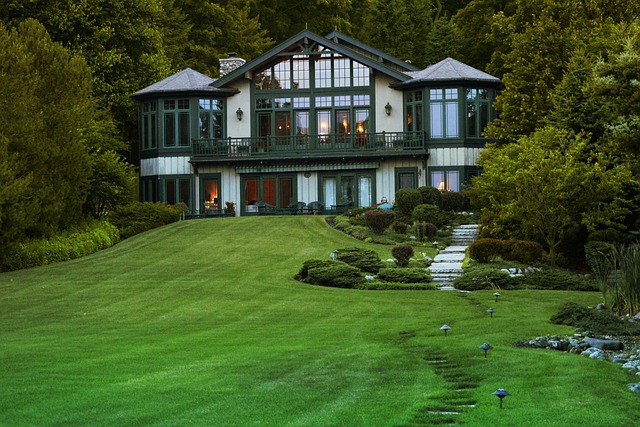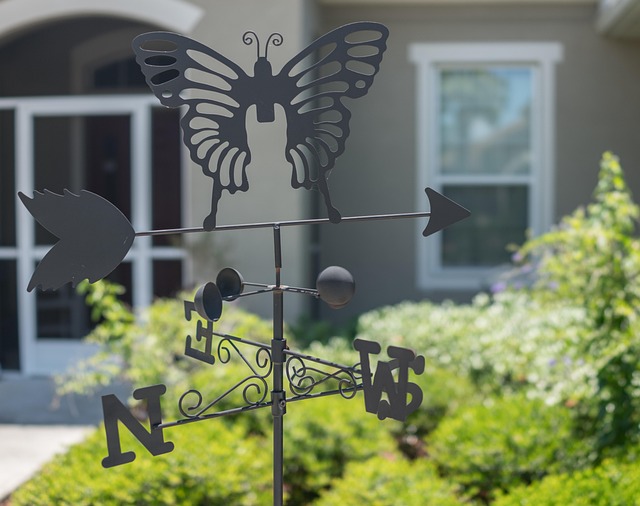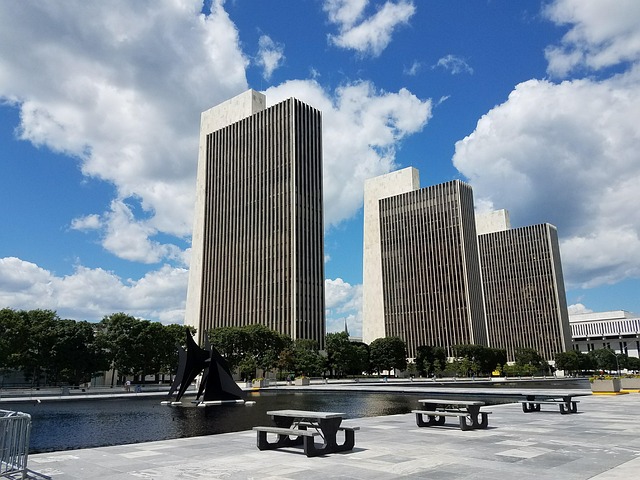Albany Landscaping: Residential vs Commercial Service Overview

Albany, NY, boasts a diverse array of landscaping services catering to both residents and businesses, offering tailored solutions from paver patios to…….
Welcome to an in-depth exploration of the captivating world of Albany landscaping, a dynamic field that transforms urban landscapes into vibrant, functional, and aesthetically pleasing environments. This article aims to guide readers through the intricacies of this discipline, highlighting its global impact, economic significance, technological innovations, regulatory frameworks, and the challenges it faces. By delving into these aspects, we will uncover how Albany landscaping not only enhances our physical surroundings but also contributes to economic vitality and sustainable development.
Definition: Albany landscaping refers to the art and science of designing, planning, and creating outdoor spaces within urban environments. It encompasses a wide range of activities, from architectural landscape design to construction, maintenance, and conservation. The primary goal is to integrate natural elements into built-up areas, fostering harmony between humans and their surroundings.
Core Components:
Design: This involves conceptualizing and creating detailed plans for landscapes, considering factors like functionality, aesthetics, and environmental sustainability. Architects, designers, and landscape architects collaborate to translate client visions into reality.
Construction: Execution of the design requires skilled contractors specializing in various landscaping techniques, including hardscaping (e.g., patios, walls) and softscape installations (e.g., planting schemes, water features).
Maintenance: Post-construction, regular upkeep ensures the longevity and visual appeal of landscaping features. This includes lawn care, gardening, pruning, and seasonal maintenance tasks.
Historical Context: The practice of Albany landscaping has evolved over centuries, reflecting changing societal values and aesthetic preferences. From formal garden designs of the Renaissance to the naturalistic landscapes of the 19th century, the discipline has continually adapted to meet the needs of urban dwellers. Today, it stands as a vital component of urban planning, contributing to improved quality of life, environmental sustainability, and economic development.
Albany landscaping transcends national borders, influencing global design trends and cultural landscapes. Here’s an overview:
International Exchange: The sharing of design ideas and techniques across continents has fostered a diverse and dynamic landscape architecture community. For instance, the Japanese zen garden concept has inspired similar tranquil outdoor spaces worldwide, while modern urban landscaping in Scandinavia emphasizes sustainability and minimalism.
Sustainable Development Goals: Global initiatives like the United Nations’ Sustainable Development Goals (SDGs) significantly impact Albany landscaping. Goal 11, “Sustainable Cities and Communities,” encourages sustainable urbanization, green infrastructure development, and access to green spaces, driving innovative landscaping solutions.
Regional Variations: Different regions embrace unique landscaping styles. The Mediterranean climate influences landscape design in California with its emphasis on drought-tolerant plants and outdoor living. Similarly, the Arctic landscapes of Norway inspire cold-climate gardening techniques and hardscaping adaptations.
The Albany landscaping industry is a significant economic sector, contributing to job creation, business growth, and local economies:
| Economic Aspect | Description |
|---|---|
| Market Size | The global landscaping market was valued at USD 147.5 billion in 2020 and is projected to grow at a CAGR of 6.8% from 2021 to 2028 (Source: Grand View Research). |
| Job Creation | Landscaping services employ millions worldwide, offering opportunities for skilled labor, entrepreneurship, and seasonal work. |
| Business Opportunities | The industry supports small local businesses to large multinational corporations, catering to diverse client needs, from residential gardens to commercial projects. |
| Economic Impact | Well-designed landscapes enhance property values, attract tourists, and stimulate local economies. For instance, a study in the UK found that homes with well-maintained gardens have higher resale values (Source: Royal Horticultural Society). |
Technology plays a pivotal role in shaping the future of Albany landscaping:
3D Modeling and Design Software: Advanced design tools allow architects and designers to create detailed 3D models, enhancing client visualization and precision in landscape construction.
Smart Irrigation Systems: Technology-driven irrigation systems optimize water usage, ensuring plants receive the right amount at the right time. This contributes to sustainable landscaping practices.
Drone Technology: Drones are increasingly used for site surveys, mapping, and monitoring landscape progress, providing efficient and cost-effective solutions.
Geospatial Data Analysis: Advanced data analytics helps in understanding site conditions, soil types, and climate patterns, enabling better design decisions.
Regulatory bodies play a crucial role in ensuring responsible and sustainable landscaping practices:
Zoning Laws: Local governments often have zoning regulations that dictate land use and landscaping requirements for different areas, ensuring harmony with surrounding neighborhoods.
Environmental Permits: For larger projects, permits may be required to protect sensitive ecosystems and ensure compliance with environmental protection laws.
Building Codes: These codes specify construction standards, including landscaping elements like drainage systems and safety features.
Sustainable Practices: Many regions encourage or mandate sustainable landscaping practices, such as water conservation, use of native plants, and reduced chemical applications.
Despite its benefits, Albany landscaping faces several challenges:
Cost and Budget Constraints: Large-scale projects often face budget limitations, impacting design quality and materials used. Creative financing models and cost-effective solutions are essential to address this.
Maintenance Backlog: In underfunded public spaces, maintaining landscapes can be challenging, leading to a decline in aesthetics and functionality. Regular maintenance planning and community engagement strategies can help mitigate this issue.
Lack of Green Spaces in Urban Areas: High-density urban environments often struggle with limited green space access. Creative solutions like vertical gardening and shared green roofs can enhance urban landscape accessibility.
Strategies for Overcoming Challenges:
Public-Private Partnerships: Collaborating with private sector entities can bring additional resources and expertise to landscaping projects.
Community Engagement: Involving local communities in design processes fosters a sense of ownership and ensures landscapes meet diverse needs.
Innovative Funding Models: Exploring alternative funding sources, such as crowdfunding or impact investments, can support ambitious landscaping initiatives.
This iconic linear park in Manhattan transformed a former elevated train line into a vibrant green space. The project involved creative landscape design, incorporating native plants and public art. It successfully revitalized the neighborhood, attracting tourists and residents alike.
Key Takeaways:
Singapore has embraced green landscaping on a grand scale, integrating nature into its urban fabric. The “City in a Garden” concept includes extensive parks, vertical gardens, and green roofs. This initiative enhances environmental quality, reduces the urban heat island effect, and provides recreational spaces for residents.
Lessons Learned:
Italian Renaissance gardens represent a historical masterpiece in landscaping, blending architecture, sculpture, and natural beauty. These gardens, such as Villa d’Este and Boboli Gardens, showcase the era’s artistic vision and horticultural expertise. Today, they remain popular tourist destinations, inspiring modern landscape designers worldwide.
Historical Relevance:
The field of Albany landscaping is poised for exciting growth and evolution:
Sustainable Urban Drainage Systems (SUDS): Emphasizing natural drainage solutions reduces urban flooding risks and enhances water quality.
Biophilic Design: Incorporating nature into built environments improves well-being and productivity, leading to increased demand for green spaces and biomorphic design elements.
Smart Cities Integration: Landscaping will play a critical role in creating sustainable smart cities, with connected lighting, sensors, and data analytics enhancing urban experiences.
Vertical Landscaping: As space becomes scarce, vertical gardens, green walls, and roof top farms will become more prevalent, providing food production and aesthetic benefits.
Albany landscaping is not merely about creating beautiful outdoor spaces; it is a catalyst for economic growth, environmental sustainability, and improved quality of life. As cities continue to grow, the discipline will play an increasingly vital role in shaping urban landscapes that are functional, aesthetically pleasing, and resilient. By embracing technological advancements, fostering public-private partnerships, and prioritizing sustainable practices, Albany landscaping professionals can navigate challenges and propel the industry forward.
Q: How does Albany landscaping contribute to environmental sustainability?
A: It promotes sustainable practices like water conservation, use of native plants, and reduced chemical applications. These methods protect ecosystems, reduce pollution, and preserve biodiversity.
Q: What role do technology and innovation play in modern landscaping?
A: Technology enables precise design, efficient construction, and smart maintenance through tools like 3D modeling, drone surveys, and automated irrigation systems. Innovations enhance both design quality and sustainability.
Q: How can communities get involved in local landscaping projects?
A: Community engagement strategies include public meetings, online consultations, and volunteer programs. Involving residents ensures landscapes reflect local needs, fosters a sense of ownership, and encourages pride in public spaces.
Q: Are there any global trends shaping the future of urban landscaping?
A: Yes, global trends include sustainable development goals, biophilic design, smart cities integration, and vertical landscaping. These trends influence how we design and interact with urban spaces worldwide.

Albany, NY, boasts a diverse array of landscaping services catering to both residents and businesses, offering tailored solutions from paver patios to…….

Albany's diverse climate inspires unique landscaping trends, from seasonal planting choices to eco-friendly practices. Spring brings vibrant bloo…….

Albany's premier landscaping services transform outdoor spaces into vibrant oases, catering to residential and commercial clients. They offer a d…….

When planning Albany landscaping, understanding your budget is crucial. Define your financial limits and consider various costs like design, installat…….

Albany's urban landscape serves as a creative muse for skilled landscaping artists who prioritize tree care. Numerous design firms specialize in…….

Evaluating and enhancing your home's front entrance through Albany landscaping is a strategic move to boost curb appeal and property value in the…….

Retaining walls are crucial structural elements in Albany landscaping, offering functional benefits like soil erosion control and slope stabilization,…….

Adding a pathway in Albany landscaping improves functionality and visual appeal, with material choices ranging from rustic stones to modern concrete……..

Albany landscaping companies are at the forefront of a sustainable design revolution, prioritizing biodiversity and ecosystem support through native p…….